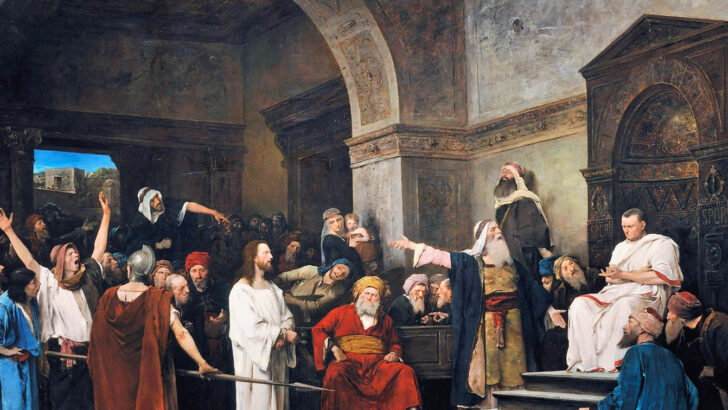The events surrounding the Passion and death of Jesus feature many interesting characters who show up and are then entered into legend. Joseph of Arimathea, Simon of Cyrene, the centurion. But among the secret believers is one who is not, one who in fact seemed to be the opposite of Jesus and that is the ironically named Jesus Barabbas (though it is disputed whether his name is Jesus).
In the first volume of Jesus of Nazareth, Pope Benedict XVI notes that Origen, an early Church Father, claimed many Gospel manuscripts identified Barabbas as ‘Jesus Barabbas’ until the third century. ‘Bar-Abbas’ means ‘son of the father,’ a title often attributed to messianic figures. The Gospel of Matthew further describes Barabbas as a “notorious prisoner,” suggesting he held a significant place in the resistance. Pope Benedict argues that Barabbas was likely the leader of the uprising that led to his imprisonment. A murderer, a revolutionary, a zealot.
Deliverer
These details suggest that Barabbas, like Jesus, was considered by some to be the awaited deliverer of the Jewish people. Not only were both men accused of the same crime, but they may have shared the same first name and the same title. However, only Jesus of Nazareth truly claimed and fulfilled this role. The crowd’s choice of Barabbas over Jesus reflects a deeper struggle: they preferred a saviour who promised liberation through armed struggle rather than one who proclaimed that true life is found in losing oneself.
The contrast between Jesus and Barabbas is striking. Barabbas, whose name means ‘son of the father,’ represents a worldly messiah—a revolutionary who seeks political freedom through violence. As the Gospels recount, the people chose Barabbas over Jesus (Mt 27:21), a choice that symbolises humanity’s repeated preference for immediate power over the mysterious and sacrificial path to true salvation. Pope Benedict notes that this choice is not merely between two men but between two types of messianic hope: one that offers earthly power and another that brings redemption through humility and suffering. True kingship, he argues, comes not from force but from submission to God’s will, even unto the Cross.
Fascinate
But the figure of Barabbas has continued to fascinate scholars and writers alike. One of the most notable literary explorations of Barabbas is Pär Lagerkvist’s novella Barabbas (1950), which imagines his life after his unexpected release.
In Lagerkvist’s depiction, Barabbas is haunted by the man who took his place. He is struck by the innocent looking Jesus who was to take his place on the cross. Though he follows Jesus’ procession to the cross and witnesses the darkness that falls at his death, he cannot bring himself to believe. His fascination with Jesus leads him to seek out his followers, but they reject him—except for Peter, who treats him with kindness.
Barabbas continues to drift on the margins of belief, drawn to Christians but unable to embrace their hope. He wanders Rome, seeking a Christian meeting place, still haunted by their doctrine of love. When he sees flames consuming the city, he interprets it as the apocalyptic return of Jesus, believing that Christ has come at last to bring judgment. But instead of worship, Barabbas responds in the only way he knows—by spreading the fire.
Lagerkvist presents Barabbas as a man trapped in the tension between belief and doubt, drawn to Christ yet unable to surrender to him”
He sees himself as finally acting for Christ, though his actions are violent rather than faithful. His confused sense of purpose leads him to destruction rather than redemption. He is then imprisoned and sentenced to death on a cross. The final image of Barabbas is one of darkness. As he is crucified, he at last gives up the ghost, echoing the darkness that descended when Jesus died. He utters the words, “To thee I deliver up my soul,” leaving it unclear whether he has finally turned to Christ or not.
Lagerkvist presents Barabbas as a man trapped in the tension between belief and doubt, drawn to Christ yet unable to surrender to him. His story is one of missed opportunities, of standing on the threshold of faith but never stepping through. The contrast with various Christian martyrs is stark: they embrace suffering with hope, while Barabbas sees only despair.
Meditation
Through Barabbas, Lagerkvist offers a meditation on doubt, grace, and the nature of belief. Barabbas represents all who stand at the crossroads, confronted by Christ yet unable to fully accept him. His story is tragic, but it serves as a reminder of the radical choice presented to every soul: to embrace the suffering Christ or to turn away. In the end, Barabbas’ journey is a reflection of the choice made by the crowd at the trial—between a messiah of force and a Messiah of love.


 Christ before Pilate, Mihály Munkácsy
Christ before Pilate, Mihály Munkácsy 